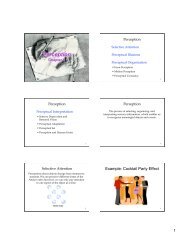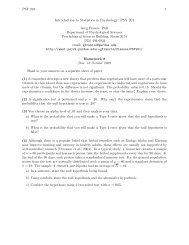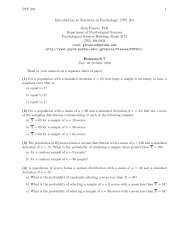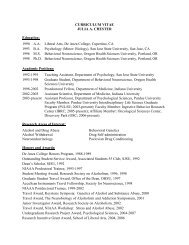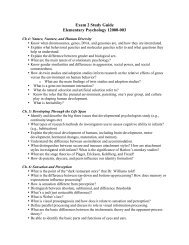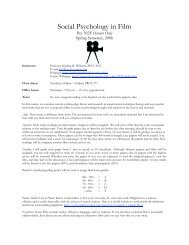Prof. Greg Francis 1/2/12 PSY 200: Intro. to ... - Purdue University
Prof. Greg Francis 1/2/12 PSY 200: Intro. to ... - Purdue University
Prof. Greg Francis 1/2/12 PSY 200: Intro. to ... - Purdue University
Create successful ePaper yourself
Turn your PDF publications into a flip-book with our unique Google optimized e-Paper software.
<strong>Prof</strong>. <strong>Greg</strong> <strong>Francis</strong> 1/2/<strong>12</strong>DifferencesWe have <strong>to</strong> look for differences in activityAlzheimer’s patients have reduced brain activityA simple experimentSuppose you run an fMRI experiment where a person alternatesbetween seeing a blank screen and a faceYou take multiple fMRI scans with half recording brain activity duringthe blank and half recording brain activity during the faceAdd them up pixel by pixel for each conditionViewing blankViewing face<strong>Purdue</strong> <strong>University</strong><strong>Purdue</strong> <strong>University</strong>Subtraction methodSubtract the fMRI signals produced by one condition from the fMRIsignals produced by another conditionThe difference map indicates those brain regions that are involved inthe different cognitive tasksIt requires a sophisticated statistical analysis <strong>to</strong> avoid false positives!Viewing blankViewing face<strong>Purdue</strong> <strong>University</strong>Difference mapWhat is usuallyreported is just thedifference mapColors mark placesin the brain that arestatistically differentbetween conditions Czisch et al. (<strong>200</strong>9)for rare <strong>to</strong>nes vs.frequent <strong>to</strong>nesThe map would bedifferent if itcompared rare <strong>to</strong>nesversus speechReporting<strong>Purdue</strong> <strong>University</strong>Functional MRIFunctional MRIColor maps showstrongest“responses”e.g., during a taskthat requires covertspatial attentioncompared <strong>to</strong> one thatdoes not requireattentionWhen moving apointer <strong>to</strong> a targetbox compared <strong>to</strong> nomovement “activity” in areasinvolved in vision,planning, and mo<strong>to</strong>rcontrol<strong>Purdue</strong> <strong>University</strong><strong>Purdue</strong> <strong>University</strong><strong>PSY</strong> <strong>200</strong>: <strong>Intro</strong>. <strong>to</strong> Cognitive Psychology 4
<strong>Prof</strong>. <strong>Greg</strong> <strong>Francis</strong> 1/2/<strong>12</strong>LimitationsBrain scans do not really tell us how the brainworks the scans just tell us approximately where in the brainsomething occurs sometimes it can tell approximately whenEven trying <strong>to</strong> find the place may be problematic Lots of cognitive abilities involve many different areasof the brainMost of the time theories of cognition are derivedfrom experimental psychology Brain studies explore how <strong>to</strong> implement the theories<strong>Purdue</strong> <strong>University</strong>Common misconceptionBrain scans demonstrate a physiological basis <strong>to</strong>things that were thought <strong>to</strong> be emotionally orcognitively based e.g., MRI scansof stutters in fact, allbehavioral traitsare physiologicallybased<strong>Purdue</strong> <strong>University</strong>ConclusionsLots of research in this areaTechnology is improving in many waysThere are many other types of scanningtechnologies Computerized Axial Tomography (CAT) Diffusion tensor imaging (DTI) Single Pho<strong>to</strong>n Emission Computed Tomography(SPECT) Near Infrared Spectroscopic Imaging (NIRSI) Magne<strong>to</strong>encephalography (MEG) Positron Emission Tomography (PET)<strong>Purdue</strong> <strong>University</strong>Next timeHow do we use brain scans <strong>to</strong> studycognition?How good are the scans?What is really being measured?How <strong>to</strong> read someone’s mind.<strong>Purdue</strong> <strong>University</strong><strong>PSY</strong> <strong>200</strong>: <strong>Intro</strong>. <strong>to</strong> Cognitive Psychology 5


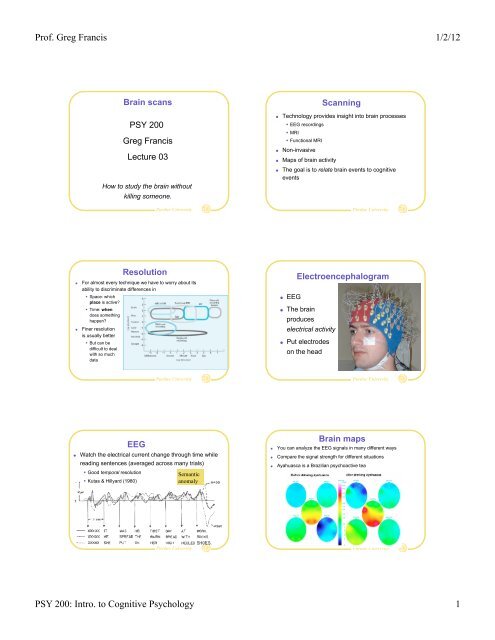

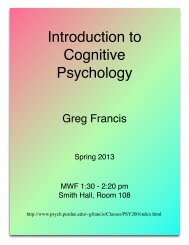
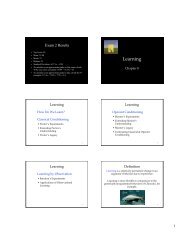
![Exam 4 Study Guide[1]](https://img.yumpu.com/45196739/1/190x245/exam-4-study-guide1.jpg?quality=85)
